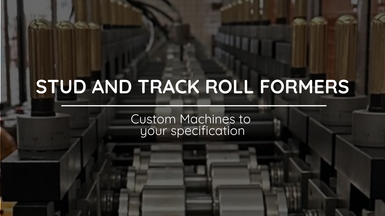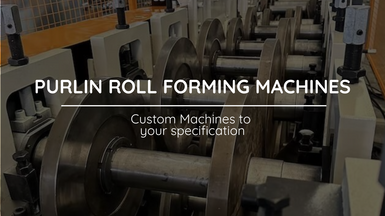
Slit-to-Recoil Line
These lines are crucial for industries like automotive, construction, and metal fabrication where different sizes of metal strips are needed
Posted on Wednesday, September 18, 2024
A Slit-to-Recoil Line is a metal processing system designed to slit large coils of metal into narrower strips, which are then recoiled for easier handling, storage, and transportation. These lines are widely used in industries that require precise cutting of metal coils to produce smaller widths for further processing or sale.
Key components of a Slit-to-Recoil Line typically include:
- Uncoiler: This holds the master coil and feeds it into the slitting line.
- Slitting Machine: Equipped with rotary knives, this machine precisely cuts the coil into the desired widths.
- Tensioning Unit: Maintains the proper tension to prevent slippage or wrinkles during the slitting process.
- Recoiler: After slitting, the narrow strips are recoiled into smaller coils for shipment or further use.
These lines are crucial for industries like automotive, construction, and metal fabrication where different sizes of metal strips are needed
The Slit-to-Recoil Line is a highly specialized and automated system used for cutting wide metal coils into narrower strips and recoiling them for easier handling and distribution. Here's a more detailed breakdown of the process and its key components:
1. Uncoiler
- The process begins with the uncoiler, which holds a large master coil of metal. This coil can be made of various materials like steel, aluminum, or copper.
- The uncoiler feeds the metal sheet into the slitting line in a controlled and steady manner, ensuring smooth operation.
2. Slitter Head (Slitting Machine)
- Slitter knives are mounted on the slitting head. These knives, made of durable materials, are set at specific intervals depending on the required width of the strips.
- The coil is fed through these rotary knives, which cut the wide coil into narrower strips with precision. The number of strips cut depends on the width of the input coil and the desired output sizes.
- This process can cut coils into a range of widths, from very narrow strips to larger sections.
3. Looping Pit or Accumulator
- After the slitting process, the metal strips enter a looping pit or accumulator, which maintains tension and avoids any tension fluctuations that could affect the quality of the cut. This buffer area allows for continuous operation even as other parts of the line slow down or speed up.
4. Tensioning Unit
- The tensioning unit ensures that the metal strips remain taut during the process, preventing wrinkles, scratches, or misalignment during slitting and recoiling. The system applies back tension, keeping the metal strips straight and orderly.
5. Recoiler
- Once the metal is slit into the desired widths, the narrow strips are fed into the recoiler, where they are rewound into smaller coils.
- These newly formed coils are much easier to handle and are often prepared for shipping or additional manufacturing processes.
6. Edge Trimmer
- Optional but common in modern lines, an edge trimmer can be used to remove rough or uneven edges from the slit strips. This enhances the quality of the final product.
7. Coil Packaging
- After recoiling, the strips are secured, often with metal or plastic straps, to ensure they stay intact during handling and transportation.
Key Features and Benefits of a Slit-to-Recoil Line:
- Precision: High-quality slitting machines can produce extremely accurate cuts, ensuring consistency across large volumes of material.
- Efficiency: Automated control systems allow for continuous, high-speed operation, maximizing production efficiency.
- Flexibility: Can process a wide variety of metals and thicknesses, making it adaptable to different industries such as automotive, construction, and appliance manufacturing.
- Material Handling: Slit-to-recoil lines can handle different coil sizes, widths, and thicknesses, offering flexibility depending on the project requirements.
Applications of Slit-to-Recoil Lines:
- Automotive Industry: Produces metal strips used in vehicle parts and components.
- Construction: Supplies material for structural elements like beams and roofing systems.
- Metal Fabrication: Provides raw materials for various fabrication processes.
- Packaging: Supplies narrow strips for packaging industries where metal bands or strips are used.
These systems are integral to industries where metal sheet processing is vital, ensuring that materials are efficiently and accurately prepared for further processing or end use.
Let's dive deeper into some of the technical aspects of the Slit-to-Recoil Line. We'll break down each part of the process and focus on the technical specifications, common challenges, and best practices associated with these systems.
1. Uncoiler (Decoiler)
- Technical Aspects: The uncoiler is usually motorized and equipped with hydraulic expansion arms to secure the coil in place. It can support various coil weights (ranging from 5 to 30 tons or more) and widths (up to 2000 mm or more). Advanced uncoilers can adjust tension to prevent slippage as the coil feeds into the slitter.
- Best Practice: Ensuring the coil is properly aligned before it feeds into the slitter is essential to avoid poor slitting quality and uneven recoiling.
2. Slitting Machine (Slitter Head)
- Technical Specifications:
- Knives: Made of high-grade tool steel or carbide to resist wear, especially for hard materials like stainless steel or aluminum. They come in a range of thicknesses to accommodate different materials.
- Spacing: The knives can be adjusted to achieve precise slit widths. The spacers and rubber rings between knives ensure consistent spacing.
- Clearance Settings: Adjusting the clearance (the gap between the slitting knives) is critical. Too small a clearance may damage the knives or burr the material, while too large a clearance can result in poor quality cuts or rough edges.
- Speed: The slitting machine can operate at speeds ranging from 100 to 300 meters per minute, depending on the material type, thickness, and quality required.
- Challenges: Proper knife alignment and clearance setting are critical for a clean cut without burrs or material deformation. Misalignment can lead to quality issues or damage to the equipment.
3. Tensioning Unit
- Technical Aspects: The tensioning unit applies a controlled amount of force to ensure the strips are taut but not overstretched. A key aspect of this process is the use of a brake or tensioning roll to maintain consistent pressure as the material moves from the slitter to the recoiler.
- Types of Tensioning Systems:
- Drag Pad: Utilizes felt or rubber pads to create friction for the metal strips.
- Braking System: A mechanical or hydraulic brake applies tension. In high-end systems, digital control allows for real-time adjustments to the tension based on the thickness and type of material.
- Best Practice: Regular calibration of tensioning systems is crucial to ensure high-quality slitting, as improper tension can cause misaligned cuts, wrinkles, or coil breakage.
4. Recoiler
- Technical Aspects: The recoiler winds the narrow strips into smaller coils. Depending on the system, it can support recoiling speeds up to 200 meters per minute. Hydraulic or mechanical expansion systems are used to secure the coil core during recoiling.
- Core Size: Standard coil cores are usually 508 mm (20 inches) or 610 mm (24 inches), but many machines allow for adjustable cores to handle varying coil sizes.
- Best Practice: It's important to monitor coil build-up on the recoiler to avoid uneven winding, which can cause issues during downstream processes like stamping or forming. Automatic tension control is often used to maintain consistent winding pressure.
5. Edge Trimmer
- Technical Aspects: The edge trimmer is used to remove irregularities or rough edges from the slit strips, providing a smooth finish that’s important for applications where surface quality is critical (e.g., in automotive or appliance manufacturing).
- Best Practice: Ensuring the trimmer blades are sharp and properly aligned ensures a clean, burr-free edge. Regular maintenance of the trimmer is essential to maintain quality over time.
6. Material Handling and Automation
- Automation: Modern Slit-to-Recoil Lines are often fully automated, with sensors and computer controls managing the entire process from uncoiling to recoiling. Automation systems can adjust knife settings, tension, and speed based on input material specifications.
- Coil Transfer Systems: Automated systems are used to handle heavy coils, both for loading the uncoiler and for removing the recoiled strips. This reduces manual labor and improves safety.
- Challenges: Implementing effective automation requires proper setup of feedback loops and control systems. Sensors must be accurately calibrated to ensure the line functions at optimal speeds while maintaining precision.
Challenges in the Slit-to-Recoil Process
- Material Properties: Different metals have different properties such as tensile strength, ductility, and hardness. These properties must be considered when adjusting slitter clearance and tension to avoid poor cuts or damage to the equipment.
- Burr Formation: Burrs are a common issue when slitting, especially if the knife clearance is not properly set. Burrs can affect downstream processes and require additional steps like deburring.
- Strip Camber: This occurs when the slit strip curves rather than remaining straight. It’s typically caused by improper knife alignment or unequal tension during slitting. Controlling strip camber is critical, especially for high-precision industries like aerospace or electronics.
- Heat Generation: During high-speed slitting, friction between the material and the slitting knives can generate significant heat, potentially causing warping or material degradation. Lubrication or cooling systems are often used to mitigate this.
Advanced Features in Modern Slit-to-Recoil Lines
- Laser Measurement Systems: Real-time laser measurement ensures the slitting process is meeting precise width tolerances. These systems can detect deviations as small as microns and automatically adjust knife positions.
- Automatic Knife Positioning: In highly advanced systems, the knife positions can be adjusted automatically based on pre-programmed material specifications, reducing setup times and increasing production efficiency.
- Integrated Surface Inspection: Some lines include surface inspection systems that detect defects such as scratches, dents, or oil spots during the slitting process, ensuring high-quality output.
Maintenance and Care
- Regular Knife Sharpening: Dull knives are a major cause of poor-quality cuts and increased burr formation. Regular sharpening or replacement is essential to maintain the system’s performance.
- Tension Calibration: Tensioning units must be regularly calibrated to prevent over-stretching or under-tensioning of the material, which can result in poor-quality coils or operational issues.
- Alignment Checks: Ensuring that the slitter knives are properly aligned and that the coil is loaded correctly helps avoid common issues such as camber, burrs, and material deformation.
Roll Forming Machines LLC's New Factory
Posted on Sunday, March 23, 2025
We have relocated factories, which will be available for tours very soon.

Uncoiler, Decoiler and Coil Car Roll Forming Machine Accesories from Roll Forming Machines LLC
Posted on Sunday, November 24, 2024
Contact us today with your specifications for a custom Uncoiler, Decoiler or Coil Car at [email protected] or call us at (+1) (407) 859 1119

Stud and Track Roll Forming Machines from Roll Forming Machines LLC
Posted on Saturday, November 23, 2024
Contact us today with your specifications for a custom Stud and Track Machine at [email protected] or call us at (+1) (407) 859 1119

Cee and Zee Purlin Roll Forming Machines from Roll Forming Machines LLC
Posted on Saturday, November 23, 2024
Contact us today with your specifications for a custom Cee and Zee Purlin Machine at [email protected] or call us at (+1) (407) 859 1119